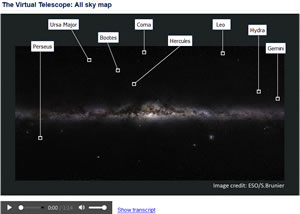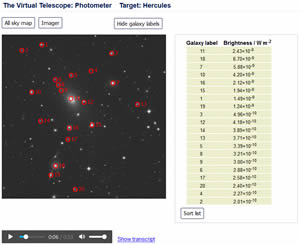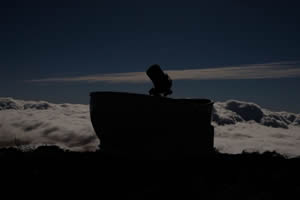Astronomy Education
Here we highlight links between the research carried out by staff within the Astronomy Research Group and the OU’s teaching. We also present the various education research projects which astronomy academic staff have undertaken.
Links between Research and Teaching


All academic staff in the Astronomy Research Group have leading roles in the production and presentation of learning and teaching materials at all levels of the OU curriculum.
We produce informal learning materials for OpenLearn, including Badged Open Courses (BOCs), one of which focusses on our core research area of exoplanets. We also contribute to Massive Open Online Courses (MOOCs) for Futurelearn. We maintain a separate web portal, www.telescope.org, to provide informal learners and interested members of the public with intuitive access to our robotic telescopes in Tenerife.
Astronomy modules feature in pathways for the MPhys Master of Physics degree, BSc (Hons) Physics degree, the BSc (Hons) Natural Science degree and the BSc (Hons) Mathematics and Physics degree, as well as the OU’s BSc (Hons) Open degree and BSc (Hons) Combined STEM degree.
At Level 1 of the OU curriculum we are responsible for Astronomy content within the interdisciplinary science module, S111 Questions in science; the foundation module for the physical sciences curriculum, SM123 Physics and space; and the standalone short module, S177 Galaxies, stars and planets. Between them, these modules provide an introduction to all our astronomy research from exoplanets, to stellar systems, to galaxies and cosmology.

The PIRATE optical telescope
At level 2, the core astronomy module is S284 Astronomy whose learning materials are centred around seven topics delivered online that incorporate up-to-date advances in multiwavelength stellar and extragalactic astronomy. The level 2 practical module, SXPA288 Practical science: physics and astronomy, includes projects using our robotic optical telescope to investigate colour-magnitude diagrams of star clusters. As well as being central to our teaching of practical astronomy, our robotic telescope PIRATE is also used as a key part of our research, particularly to investigate transiting exoplanets and transient stellar phenomena.
At level 3, our modules link closely to the research activities of the Astronomy Research Group. The module S384 Astrophysics of stars and exoplanets includes two core texts on stars and exoplanets and a series of case studies reflecting cutting-edge research, as well as a practical project in which students use our robotic telescope to make photometric observations of exoplanet transits. The module S385 Cosmology and the distant Universe is focuses on the Universe on the largest scales, and examines how today’s stars and galaxies came to exist. It also explores a variety of phenomena of the distant Universe, from the earliest galaxies to black-hole jets and gamma-ray bursts. Finally the project module, SXP390 Science project course: radiation and matter allows students to carry out in-depth projects in astronomy areas including gravitational lensing, exoplanets and astrophysical jets.
At postgraduate level, Astronomy staff are also central to the MSc in Space Science and Technology. The core moduleS818 Space scienceincludes a case study about the Gaia mission to map the Galaxy and allows students to follow-up Gaia transient alerts using our robotic telescope.
We also contribute significantly to the wider physics and general science curriculum, in a range of modules.
Education Research projects by Astronomy staff
Academics in the Astronomy Research Group have led a number of education research projects, in collaboration with eSTEeM, the OU centre for STEM pedagogy. These projects focus on all aspects of teaching and learning across the physical sciences curriculum, including themes of innovative assessment, online/on-screen delivery, remote-access experiments, and supporting students. Recent projects include:
-
Assessment analytics of student engagement with, and performance on, S217 online quizzes – Andrew Norton (PI)
This project used analytics information to investigate student engagement with, and attitudes towards, the online interactive quizzes that form part of S217 Physics: from Classical to Quantum.
-
Developing practice in online synchronous tuition by peer observation, feedback and reflection – Mark Jones (PI)
An issue in adoption of online synchronous tutorials (such as OU Live) is that training and development tends to focus on technical usage rather than reflection on teaching practice. This project investigated the role of peer observation as a developmental tool for staff involved in online teaching.
-
Students’ study of online modules – Andrew Norton (Co-I)
The aim of this study was to obtain data on how students studied online modules and to use this to put in place amendments to the current presentation where this could be easily done or to subsequent presentations to enhance the students’ experience.
-
Implementation of lessons learnt from students who succeed “despite the odds” – Andrew Norton (Co-I)
In this project data gathered allowed the authors to investigate a hitherto neglected, but important, cohort of successful students – those who really shouldn’t have succeeded because all the odds were stacked against them.
-
Perceptions, Expectations and Experience of Group Tuition: towards a shared understanding amongst stakeholders – Mark Jones (Co-I)
This project was concerned with supporting the Open University Group Tuition Strategy by identifying and developing a common understanding across various stakeholders of good (group) tuition practice in the Open University.
-
Exoplanets BOC: Enhancing and Evaluating a Badged Open Course in Science – Carole Haswell (PI)
The project’s aims are to develop GeoGebra objects to support and develop the content of the BOC and to evaluate the effectiveness of the BOC and the elements comprising it.
-
Online Team Investigations in Science (OTIS) – Mark Jones (PI), Judith Croston, Sheona Urquhart, Ulrich Kolb (Co-Is)
By taking a comparative approach between three online team investigations in planetary science and astronomy, this project aimed to investigate the factors that may be important in determining the effectiveness of such activities.
- Assessing the use of robotic telescopes for university-level distance learning – Ulrich Kolb, with Marcus Brodeur, Nick Braithwaite and Shailey Minocha
This ongoing research project considers the challenges of teaching authentic university level practical science to distance learners in physics and astronomy, using robotic telescopes as examples for remote-access laboratories. The project informed the PhD research by Marcus Brodeur into the importance of realism, sociability and metafunctionality for the effectiveness of virtual and remote laboratories in teaching practical science.
There is close synergy with the work of the Physics Education Research Group on such projects.
Innovations and Spin-Offs
Astronomy has always stimulated significant engineering and IT developments, and members of the astronomy group are involved in the following areas.
Space Surveillance and Tracking – Ulrich Kolb
Our robotic telescopes are part of a network coordinated by Sybilla Technologies which are involved with Space Surveillance and Tracking work for the European Space Agency.
Data Science and Artificial Intelligence – Stephen Serjeant, Andrew Norton
We are part of the DISCNet Doctoral Training Centre.
Collaborations with CEI – Judith Croston, Carole Haswell
The CEI performs research in detector technology, working closely with Teledyne-e2v. Members of the Astronomy Discipline are working with CEI on aspects of their work on WFIRST and Athena+.
.jpg)
